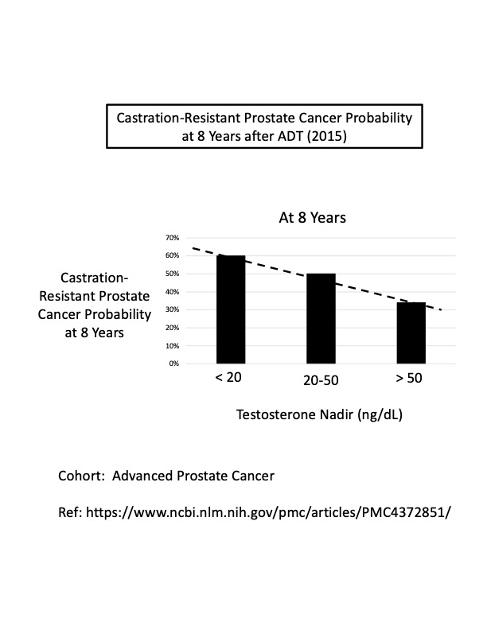Last plot. Nice linear relationship. Lower T-nadir is better.
PCa Probability versus testosterone n... - Advanced Prostate...
PCa Probability versus testosterone nadir - 7

And thanks for that...a link helps too? It looks to me like a higher nadir results in lower probability, which makes no sense? Well, sorry, you did show the link...thanks!!!!
Uggh...I mistyped the Y-axis caption. It was missing the word "Survival". That changes everything! No wonder you were confused!!
Here's the revised plot. Thanks for your excellent editing!
Bob
Thanks for the update! I guess the next question is survival for how long. I guess the graph means simply survival (as in still surviving) at that point in time.
The first original source data plot goes out to only 12 years. Note that the cohort for that plot was men with Advanced Prostate Cancer (1/2 have metastasis). So, some of the survival curves continue to decline with time and not flatten out, due to the severity of their cancer. (PCa cells mutate and become resistant to ADT castration after some time). That appears to be more so for nadir < 20 ng/dL. Too bad this plot didn't show results for nadir < 10 ng/DL.
Attached is a similar, but different, plot, showing PSA Recurrence Free Survival Probability versus time for different testosterone nadir levels. It goes out to 18 years, and the curves flatten out after about 10 years, which is very encouraging. As before, the lower the testosterone nadir level, the better the survival probability. The difference is very large for relatively small absolute changes in nadir testosterone levels.
The cohort is: Intermediate and High Risk men with PCa after RT and ADT.
ncbi.nlm.nih.gov/pmc/articl...
Bob
Here's the original source plot that shows Castration-Resistant Prostate Cancer Survival Probability for different levels of testosterone nadir. The cohort is men with advanced prostate cancer on Lupron ADT, after RT.
If you are going to castrate yourself, it makes very good sense to reduce the testosterone to below 20 ng/dL, and preferably below 10 ng/dL, by either using Lupron or high-dose transdermal estrogen. Both work the same way/same mechanism (reduced LH, FSH hormones).
Bob